

|
Back to |
| The Front Page |
| Letters & Opinion |
|
What is CROQUET DAY and where is it celebrated? By Bob Alman photographs as credited from around the world |
||||
|
||||
A "World Croquet Day" has been designated for early May. The United States observes that special day on June 8, led this year by a Facebook campaign. Many clubs try to coordinate their events accordingly, but mostly countries and regions celebrate "Croquet Day" when it best suits their calendar, their members, and the local climate. In the American south, where croquet facilities have been largely depopulated for the summer, many clubs are nevertheless mounting special playing events aimed at welcoming the public to the sport, including the national HQ of the United States Croquet Association in West Palm Beach.
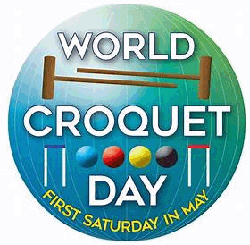
|
Perry Matson at Woodlawn in Maine wrote, " Our winter was so long this year and the Spring has been very wet and cold so our court may not be ready for play until June. Due to our court being snow and ice covered for so long, we had to have it over seeded last week. We're waiting now for some sun and warm temps to get the grass growing. Very unusual but everyone is anxious to get going. Our First tournament is June 13. We're praying for green grass by then."
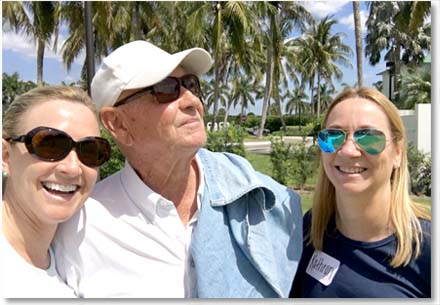
|
| Bob Alman presents his best profile, flanked by students at his Saturday Introduction to Croquet. Photo by Kathryn Robertson (right) who joined the National Croquet Center on the same day. |
From New Zealand, Chris Clarke reported, "Most of the clubs in Christchurch are currently closed until September, so we didn't celebrate world croquet day. My understanding is that none of the major croquet nations did."
The English are aware of World Croquet Day and report trying to coordinate local events with it.
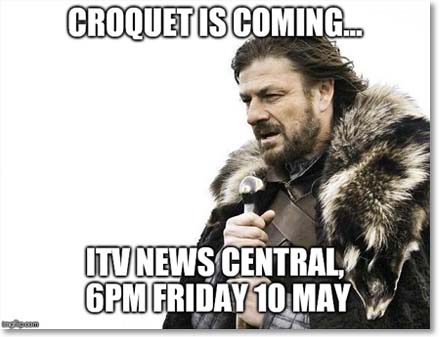
|
| Having a special day for croquet allows for valuable media coverage of the sport. In this case ITV News in Britain advertised a "special" on croquet for May 10. |
In Australia, on the other hand. Zach Kominar told me, "There's lots of activity going on around Brisbane/Queensland region; The Windsor Shield was just a coincidence to coordinate with World Croquet Day."
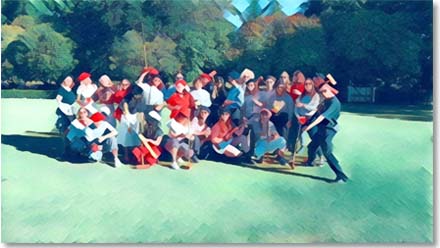
|
| Zach Kominar of the Merthyr Croquet Club in Queensland, Australia reports, " Our club didn't host any specific World Croquet Day event/activities this year as we were busy participating in competitions around town at other clubs!" Zach likes to "treat" his photos with the Prism filter. (See more of his pics here. |
You might think that because Australia is so far south, their winters would be too cold for sporting in the winter. The south ocean currents dictate otherwise. In Australia, croquet can be played year-round.

|
| On a surface this good, any day is a good day for croquet. |
|
COUNTRY CLUBS USE CROQUET AS A DRAW
At residential country clubs, there is sometimes a "croquet only" membership available to the community--as at Mission Hills in California. At others--in the North Carolina highlands, for example--the croquet is available only to members, as an amenity. The croquet committee of the Country Club of Jackson, Mississippi, wrote to us, " We actively promote croquet play among club members and country club membership in the community. We do not have a 'croquet only' membership, only full country club memberships. We sponsor a golf croquet tournament the first Saturday of May with a reception and Calcutta the Friday night before and free croquet lessons on Thursday afternoon for non-member guests. The following weekend several of our tournament players brought spouses and friends who had thoroughly enjoyed the tournament to our regularly scheduled Sunday Golf Croquet. On Memorial Day we always have a Golf Croquet round robin event for all country club members." |
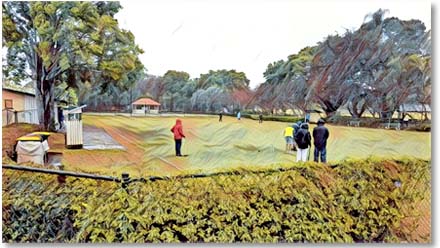
|
| This treatment suggests to me the ultimate "clubness" of the sport of croquet, played at any time, with plenty of allowance made for the weather and the climate. By Zach Kominar |
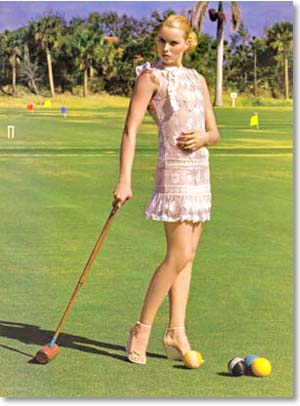
|
| If your lawn has not been aerated for while, you might allow spike heels on the court. |

|
| Bob Chilton didn't title this photograph, but to me it suggests the sweet sadness of the end of the croquet day at twilight. |
REG BAMFORD'S GROUP EVENT PLAN
Top-ranked player Reg Bamford shared on the Nottingham Board his event plan, which doubles the utility of a full-size court.
We've hosted two annual Croquet days for my staff for the last 20 years (and we now host two a year for our two offices - one at Surbiton and one in Cape Town). I've also hosted a couple of "friends and family" Croquet Days, so it's a well-oiled, tried-and-tested formula:
1. For every 16 people in attendance, you'll need one full-size court.
2. Each court is split in two, being North Court and South Court, to create two half-sized courts.
3. We play Golf Croquet, with primary colours on South Court and secondary colours on North Court.
4. I swap the red-topped hoop (Hoop 5) with Hoop 3, and put the Blue corner flag in Corner 4 and the Reg corner flag in Corner 2. So each game starts in those corners, with the simple instruction that "the first hoop you go for is the one with the colour on the top".
5. The sequence of hoops is: South Court is Hoops 1, 5, 4, 1, 5, 4, etc and North Court is Hoops 3, 6, 2, 3, 6, 2, etc. To score the hoop, you must run it in the direction towards to centre of the court (I don't confuse people with changing the direction). They can play an unlimited number of hoops in each game, continuing in the same sequence of three hoops.
6. Players pair up to play doubles. They keep the same partner throughout.
7. Play starts when I ring the bell and I allow about 20-25 minutes per game, at which point I ring the bell again signalling the end of that round. I record the score from each game.
8. I aim for each pair playing 3 rounds, so "block games" take around 3 hours.
9. I have an easel set up near the clubhouse with a big flipchart to indicate the order of play and to record the scores.
10. Once the "block games" are over, I then rank each pairing based on win % and net hoops. This determines the order in which the pairs will enter the "Peg Shoot-out". The worst pairs start the Shoot-Out, with the best pairs entering it last (a bit like the Patmore Draw at Sonoma).
11. For the Peg Shoot-out, each pair puts forward one player to compete. Pairings that were unbeaten in the block games are allowed to have both players enter the Shoot-out (that's the incentive to win all your block games).
12. The Shoot-out takes place on one court on the North/South boundary nearest the clubhouse, with everyone in attendance. I remove the relevant hoop (either hoop 5 or 6), to give an unhindered shot towards the peg. Eight players line up (players from the worst pairings go first), and all take a simultaneous shot ("on your marks, get set, go!") to land their shot near the peg. I eliminate the worst two shots, with the remaining 6 players staying in the Shoot-out. Two more players join the six, and the Shoot-out continues until there are only representatives of two pairings left. These two pairs play the final match - a "best of 3 hoops only" - in front of the clubhouse crowd.
The whole thing takes about 4 hours. If you want it to last longer, either extend the game time and/or add in an additional round. If you want it be shorter, reduce the game time and/or only have two rounds.
I do a quick introduction, explain the rules (how to grip, how to swing, the offside rules, how the day works, etc), and then do a couple of demonstration shots. The most popular ones are the jump shot over a ball, a cannon off another ball to run a hoop, a jump shot over a ball in a hoop. And then I end it with an attempt (or two!) at a Barnes-Wallis bouncing jump shot over a ball in a hoop. Lots of oohs-and-aahs, and you'll see some of the more adventurous trying these shots during the day (with very limited success).
Its enormously good fun, it's simple, and it allows people to get to meet each other in a friendly, competitive environment, where everyone is as useless at the game as the other.
Good luck with it!